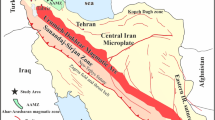Abstract
Volcanic rocks from the southern part of the Tuscan Province, the Tolfa district, range in composition from dacites to rhyolites. They have relatively high contents of many incompatible elements and their 87Sr/86Sr ratios vary between 0.7129 and 0.7148 (28 analyses) with one analysis of 0.7112. The four major eruption centres of the district can be distinguished geochemically. It is shown that the variation of major and trace elements within each area can be explained by fractional crystallization without significant crustal assimilation. The geochemical patterns of the incompatible elements of the investigated volcanics have a close similarity to the alkaline undersaturated volcanics from the nearby Roman Province. The geochemical and isotopic similarity between the Tolfa volcanics and those of the Roman Province suggests a common origin for these components of the magmas. It is suggested that, while the origin of the LIL-element enrichment of the Roman Province magmas is a mantle which was metasomatised by fluids or melts derived from upper crustal material of sedimentary origin recycled into the mantle by subduction, the Tolfa volcanics were derived directly from the subducted material by melting.
Similar content being viewed by others
References
Alvarez W (1972) Rotation of the Corsica-Sardinia Microplate. Nature Phys Sci 235:103–105
Chappel BW, White AJR (1974) Two contrasting granite types. Pac Geol 8:173–174
Clemens JD, Vielzeuf D (1987) Constraints on melting and magma production in the crust. Earth Planet Sci Lett 86:287–306
DePaolo DJ (1981) Trace element and isotopic effects of combined wallrock assimilation and fractional crystallization. Earth Planet Sci Lett 53:189–202
Dupuy C, Allegre CJ (1972) Fractionement K/Rb dans les suites ignimbritiques de Toscana. Un example de rejuvenation crustale. Geochim Cosmochim Acta 36:437–458
Fornaseri M (1985) Geochronology of volcanic rocks from Latium (Italy). Rend Soc Ital Mineral Petrol 40:73–106
Gianelli G, Puxeddu M (1979) An attempt at classifying the Tuscan Paleozoic: geochemical data. Mem Soc Geol Ital 20:435–446
Giraud A, Dupuy C, Dostal J (1986) Behavior of trace elements during magmatic processes in the crust: application to acidic volcanic rocks of Tuscany (Italy). Chem Geol 57:269–288
Hawkesworth CJ, Vollmer R (1979) Crustal contamination versus enriched mantle 143Nd/144Nd and 87Sr/86Sr evidence from the Italian volcanics. Contrib Mineral Petrol 69:151–165
Holm PM, Munksgaard NC (1982) Evidence for mantle metasomatism: an oxygen and strontium isotope study of the Vulsinian District, Central Italy. Earth Planet Sci Lett 60:376–388
Holm PM, Munksgaard NC (1986) Reply to: a criticism of the Holm-Munksgaard oxygen and strontium isotope study of the Vulsinian District, Central Italy. Earth Planet Sci Lett 78:454–459
Holm PM, Lou S, Nielsen Å (1982) The geochemistry and petrogenesis of the lavas of the Vulsinian District, Roman Province, Central Italy. Contrib Mineral Petrol 80:367–378
Le Bas MJ, Le Maitre RW, Streckeisen A, Zanettin B (1986) A chemical classification of volcanic rocks based on the total alkali-silicia diagram. J Petrol 27:745–750
Leeman WP, Phelps DW (1981) Partitioning of rare earth elements and other trace elements between sanidine and coexisting volcanic glass. J Geophys Res 86:10193–10199
Letz H, Reichert C, Wigger P, Giese P (1978) Seismic refraction measurements in the Ligurian Sea and in the Northern Appennines. In: Closs H, Rocder D, Schmidt K (eds) Alps, Apennines, Hellenides. Schweizerbart'sche Verlagsbuchhandlung, Stuttgart, pp 215–220
Locardi E, Lombardi G, Funiciello R, Parotto M (1976) The main volcanic groups of Latium (Italy): relations between structural evolution and petrogenesis. Geol Rom 15:279–300
Lombardi G, Sheppard SMF (1977) Petrographic and isotopic studies of the altered acid volcanics of the Tolfa-Cerite area, Italy: the genesis of the clays. Clay Miner 12:147–161
Marinelli G (1975) Magma evolution in Italy. In: Squyres CH (ed) Geology of Italy, I. Earth Sci Libyan Arab Republic Tripoli, pp 165–220
Miller CF (1985) Are strongly peraluminous magmas derived from pelitic sedimentary sources? J Geol 93:673–689
Pearce JA, Harris NBW, Tindle AG (1984) Trace element discrimination diagrams for the tectonic interpretation of granitic rocks. J Petrol 25:956–983
Peccerillo A (1985) Roman comagmatic province (Central Italy). Evidence for subduction-related magma genesis. Geology 13:103–106
Poli G, Frey FA, Ferrara G (1984) Geochemical characteristics of the south Tuseany (Italy) Volcanic Province: constraints on lava petrogenesis. Chem Geol 43:203–221
Rogers NW, Hawkesworth CJ, Parker RJ, Marsh JS (1985) The geochemistry of potassic lavas from Vulsini, central Italy, and implications for mantle enrichment processes beneath the Roman region. Contrib Mineral Petrol 90:244–257
Taylor HP Jr, Turi B (1976) High-18O igneous rocks from the Tuscan magmatic province, Italy. Contrib Mineral Petrol 55:33–54
Thompson RN (1977) Primary basalts and magma genesis. III. Alban Hills, Roman Comagmatic Province, Central Italy. Contrib Mineral Petrol 60:91–108
Thorpe RS, Francis PW, Hammill M, Baker MCW (1982) The Andes. In: Thorpe RS (ed) Andesites. Wiley, New York, p 724
Turi B, Taylor HP Jr., Ferrara G (1986) A criticism of the Holm-Munksgaard oxygen and strontium isotope study of the Vulsinian District, Central Italy. Earth Planet Sci Lett 78:447–453
Van Bergen MJ (1985) Common trace-element characteristics of crustal- and mantle-derived K-rich magmas at Mt. Amiata (Central Italy). Chem Geol 48:125–135
Van Bergen MJ, Ghezzo C, Ricci AC (1983) Minette inclusions in the rhyodacitic lavas of Mt. Amiata (Central Italy): mineralogical and chemical evidence of mixing between Tuscan and Roman type magmas. J Volcanol Geotherm Res 19:1–35
Vollmer R (1977) Isotopic evidence for genetic relations between acid and alkaline rocks in Italy. Contrib Mineral Petrol 60:109–118
Vollmer R (1989) On the origin of the Italian potassic magmas 1. A discussion contribution. Chem Geol 74:229–239
Washington HS (1897) Italian petrological sketches. III. The Bracciano, Cerveteri and Tolfa regions. J Geol V:34–49
Wood DA (1979) A variably veined suboceanic upper mantle. Genetic significance for mid-ocean ridge basalts from geochemical evidence. Geology 7:499–503
Author information
Authors and Affiliations
Rights and permissions
About this article
Cite this article
Clausen, C., Holm, P.M. Origin of the acidic volcanics of the Tolfa district, Tuscan Province, central Italy: an elemental and Sr-isotopic study. Contrib Mineral Petrol 105, 403–411 (1990). https://doi.org/10.1007/BF00286828
Received:
Accepted:
Issue Date:
DOI: https://doi.org/10.1007/BF00286828



